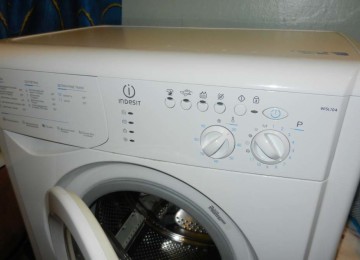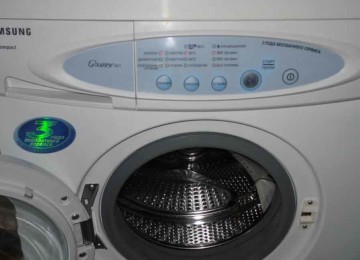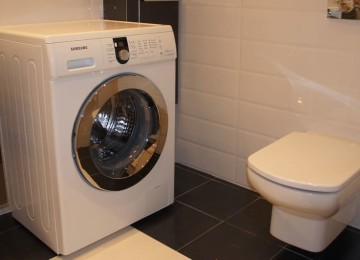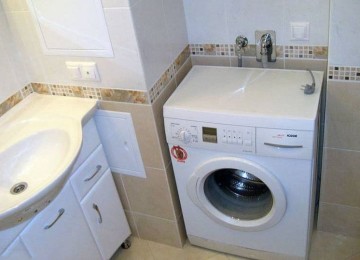 If in there is no room for a bathroom washing machine, it is most convenient to place it in the kitchen. Since all communication systems are already located here - a sewer drain and a pipe for supplying cold water. You just need to choose a suitable area, choose a model with the appropriate dimensions and hide the washing machine in the kitchen under the countertop or build it into a set.
If in there is no room for a bathroom washing machine, it is most convenient to place it in the kitchen. Since all communication systems are already located here - a sewer drain and a pipe for supplying cold water. You just need to choose a suitable area, choose a model with the appropriate dimensions and hide the washing machine in the kitchen under the countertop or build it into a set.
Advantages and disadvantages of location in the kitchen
Installing a washing machine in the kitchen – this is, as a rule, a forced event that has both its advantages and disadvantages.
The main advantages include the fact that this frees up useful space in the bathroom. You can also additionally organize your work surface. Another advantage is that you can use the washing machine at any time, regardless of whether the bathtub is free or not.
But when installing a washing machine in the kitchen, you need to prepare for certain inconveniences:
- To wash things, you first need to go into the bathroom (or another room in which there is a basket for dirty clothes), re-sort everything and put what you need into a basin, take the appropriate portion of laundry detergent along the way, and only then go to the kitchen.
- The smell of detergents is not very appropriate and useful in a room in which food is located, and all members of the canopy eat and rest.
- The noise of the washing machine when draining or spinning interferes with conversation and muffles the sound of the TV.
But the inconveniences that arise can be completely resolved. There are a number of recommendations that will help you get used to the kitchen-laundry:
- Detergent can be stored either in cabinets in sealed containers (for example, under the sink), or in another room altogether (for example, in a pantry).
- To prevent extraneous sounds and unpleasant aromas from the washing machine from interfering with food intake, you can start washing dirty clothes at night or during breaks between meals.
- If the kitchen is being built from scratch, you can arrange the floor from tiles and abandon laminate or parquet. Since ceramics are not afraid of possible leaks, and at the same time reduce the noise of the washing machine during spinning.
- To The washing machine was not so noisy, install it clearly at a horizontal level.
- To prevent washing powder from periodically spilling past the container, simply use liquid substances for washing.
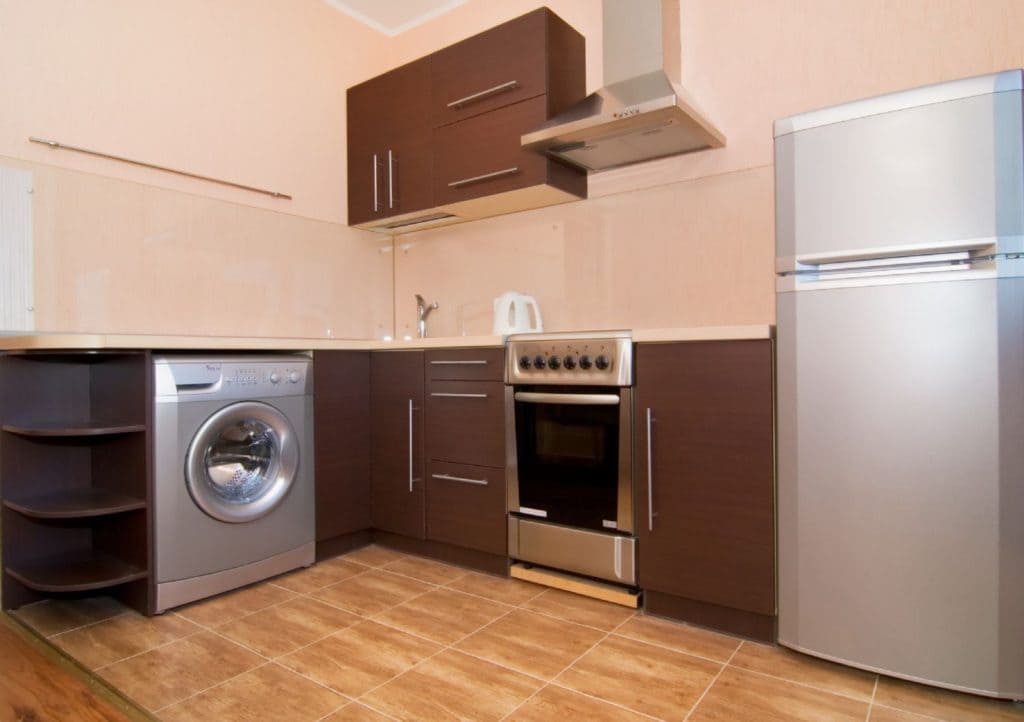
Methods for installing the washing machine
There are several options for installing a washing machine:
- Full installation in the headset.
- Partial installation in a set (for example, under a tabletop and door).
- Separate from the kitchen unit.
Full installation
By purchasing a built-in washing machine and installing it in a kitchen unit, you can completely camouflage the washing machine behind the facade, creating complete unity of surfaces. Using this method, the kitchen interior will be more attractive, while the room will visually increase in size.If the room is small, then it is advisable to use this particular option for placing the washing machine.
Disadvantage of built-in models: small range, more expensive cost, you need to unscrew the door and take the machine out of the box if the device needs to be repaired.
The only difference between built-in models and regular ones is that the former do not have a side or top protective wall. There are hinges at the front where the facade is attached.
You can also build a washing machine into the end of the kitchen unit. In this case, you need to choose a washing machine width of about 62-65 cm.
Recommendations:
- Ideally, a washing machine is necessary install near the sink and a dishwasher (regardless of whether it is a built-in model or not). This facilitates connection to communication systems and also simplifies ease of use. This way you can organize a kind of “wet” zone in which detergents are stored and there is constant access to water. In general, the unit can be built into any zone, with the only exception being the cooking stove.
- It is advisable to entrust installation to a kitchen set to a specialist.
- It is necessary to make the box so that the drain filter is always in the access area, and not completely covered by the facade.
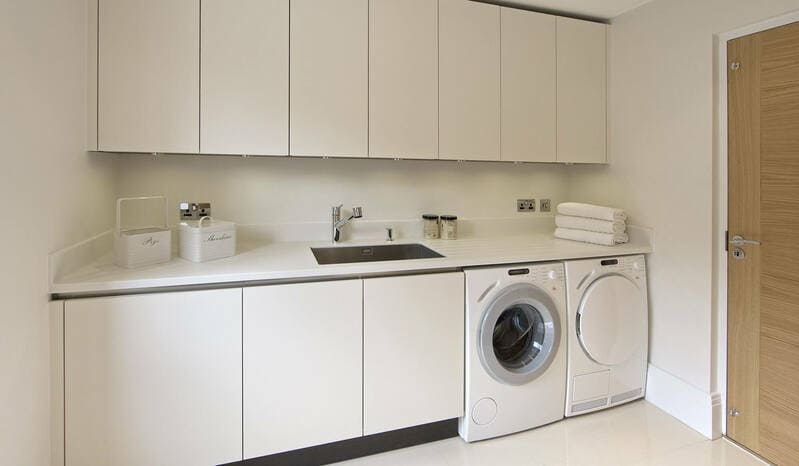
Partial installation
You can also install a regular washing machine with front-facing laundry in the kitchen set. The most important thing is to choose the right model that fits in size.This is very easy to do, since all sizes are standard and most often easily fit under the countertop.
Most often, the height of the countertop is in the range of 85-89 cm, and the height of the washing machine is usually 86 cm. If the device is slightly larger than required, it’s okay, the manufacturer probably provides the possibility of installing a washing machine and there is a removable panel on the equipment.
To remove it, you only need to unscrew a few bolts from the back. This reduces the height of the equipment by several centimeters. And to protect the washing machine from possible leaks and dirt, the top is covered with a decorative plastic sheet or covered with polyethylene.
There are several ways camouflage the washing machine under the countertop – without a door or with it.
But due to the fact that the front part of the washing device is visible, and there are small gaps near the body, the interior will not be as attractive as a complete installation. At the same time, the open part of the front panel and the gaps between the body require constant maintenance of the washing area clean and tidy.
Recommendations:
- To make the washing machine located under the countertop look presentable, it is best to choose it to match the color of the kitchen unit (the range of this equipment is small, but you can still choose) and as close in size as possible to the niche you have made.
- Do not forget that if the washing machine is installed near a wall, then the countertop must be secured to it, and not just placed on the lid of the washing machine.
- An ordinary washing machine can be decorated with vinyl stickers.
- In rustic-style rooms, baroque equipment can be disguised behind a beautiful curtain chosen to match the color of the interior.
- The most successful color of equipment is white or gray (stainless steel).
Also, the washing machine can be completely hidden behind the cabinet door if you choose equipment with a depth of 46-52 cm. In this size, the equipment can be placed in a niche and the necessary distance for the drain hose can be arranged. But when choosing a model, it is recommended to measure the depth not by taking into account the size of the case, but by the door of the washing machine with the most convex areas.
Adviсe:
- To organize access to the filter, you need to make sure that the kitchen base can be easily removed and installed back.
- It is best that the door can open more than 100 degrees. This makes it easier to put laundry in the drum of the washing machine and remove it from there.
- To ensure that the container for filling the washing powder does not rest against the door hinges during opening, you need to provide a small gap from the corresponding part of the washing machine.
Stationary installation
If the kitchen space is already equipped, then the washing machine can simply be placed in the nearest free area near the sink. If the room is small, it is best to purchase shallow equipment (46-52 cm) or a completely small-sized model with vertical stacking of linen.
Connection features

The operating conditions of a washing machine are slightly different from other kitchen electrical appliances. Primarily due to the vibrations that occur during operation and the need to properly organize the drainage of waste water.
The body of the washing machine must be installed on a rigid, moisture-resistant base. It is not recommended to place the machine on a soft or shock-absorbing surface.
Attempts to install it on a shock-absorbing base most often lead to unpleasant consequences. Any sponge material does not reduce noise and vibration, but only increases the risk of rapid bearing failure.
It is best to use a concrete screed or tiled floor as the base. If there is already parquet or linoleum, then a plywood sheet with a thickness of 17-25 mm must be laid under the equipment.
Basic Rules:
- The equipment must not be more than 5 meters away from the drain hose connection point.
- The distance from the wall to the back of the washing machine body must be at least 11-17 cm; electrical wiring and pipes must not come into contact with the kitchen unit or equipment body.
- Water is supplied to the fittings using a safety valve.
- The distance from the outlet is no more than 1 m.
- The horizontal part of the washing machine must not be filled with any items that are always in abundance in the kitchen.
- There must be a distance of 22-27 mm wide between the side part and the kitchen unit. This is required to improve heat dissipation and simplify maintenance.
Often, a washing machine is used as a stand for a microwave oven or various boxes. This is strictly prohibited. Under load, the position of the legs is deformed, this disrupts the operation of the balancing sensors. Also, when skewed, the water level changes, and the float in the chamber shuts off the drainage system before the waste water is completely poured out of the tank.
As a result, a characteristic smell of rot is formed, and the body and seals of the washing machine are subject to rapid corrosion.
When the washer is installed, you need to align the position of the legs. This will ensure normal operation of the drain and also reduce vibrations.
Step by step it looks like this:
- The surface is cleaned and impregnated with mastic.
- The cracks are sealed with putty.
- If it is impossible to lay a plywood sheet on a plank floor, the boards are simply wedged.
Leveling the washing machine can be done either with a wide dish or a building level. When leveling the dish, place it on the washing machine, then pour in a little colored liquid. Deviations from the level can be easily read along the water's edge.
To connect the washing machine to electricity, a three-core wire with a core diameter of at least 2.5 mm is used. The best option is to choose industrial wires, where there is a heat-resistant backfill under special insulation. This cable can withstand almost 24/7 loads without deformation.
When the equipment is fully connected, a test wash is started, which will show whether all installation steps were followed correctly.
A washing machine, regardless of its size and location, is a very important assistant in any home. At the same time, it can be a separate accent or simply be a beautiful addition to any kitchen interior design.






